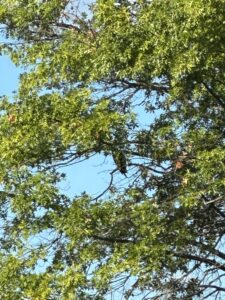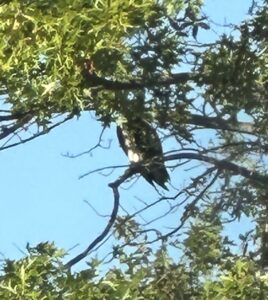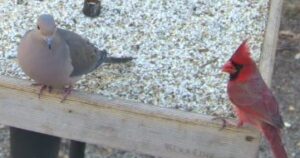What’s going at our house – OspreyOspreyOsprey!!!!!

Once again, this is why I should never leave my easy chair in front of our windows. Cleon was looking out over the lake when he spotted a large dark silhouette in our neighbor’s large oak tree. Of course, the bird was on the far side of the tree, so we were looking at it through big leafy branches. Its head was totally obscured, but it looked like maybe it had a pale neck. Cleon’s first guess was a Great Blue Heron. Mine was a Bald Eagle. Herons are common on our small lake, and we do get eagles occasionally – most especially in fall and winter. There are at least 3 active nests within about 10 miles of us.

We looked through our scope and that is when I saw the entire breast was pale and that this was a very big bird. Had to be an Osprey! In the 20 years we have lived on this small lake, we have seen 3 in migration. This was #4! Cleon finally got a brief look at the head and saw that distinctive, head with its shaggy crest. And then it took off, dove for a fish, hit the water with a big splash, but came up empty-taloned. We do have large-mouth bass in the lake. He flew off across the lake within the neighbor’s big oak and hickory trees, and we did not see it again.
If you are interested in Ospreys, allaboutbirds.org is a good place to begin. Nationwide, Ospreys were once endangered in many states, but their population numbers are improving thanks to efforts by states, groups, and individuals. Here is a link for you: Population of Ospreys (click on Conservation). Historically, Ospreys nested in Illinois. In the past 30-40 years, they have not. However, this is slowly changing. If you are interested in the efforts being made, click on this link: Osprey in Illinois
You might have noticed something different if you looked at the livestream bird feeder cam yesterday? Cleon placed our new platform feeder on its post. The old one was getting beat up and was harder and harder to keep clean. We do clean all our feeders about once a week in hot sudsy water with bleach added. The old platform feeder made of cedar wood required more and more scraping with a paint scraper to get into all the nooks and crannies. This new one has a metal mesh flooring that lifts right out so cleanup should be so easy. And cleaning the feeders is my job – in my book, easier is always better!

On the livestream, you might notice it looks like the inside edge of the feeder is sort of framed in black? That is a ‘frame’ – an edge – of sunflower seeds. Cleon observed that the cardinals so not seem to like to actually get in the platform feeder but most often, sit on the rim and grab what seed can be reached. They love the sunflower seeds so Cleon put a thick edge of black oil sunflower seeds along the edges of this platform so now the cardinals can sit where they like to sit and reach their favorite seeds with ease. That Cleon! He sure takes care of what he loves. He always has a fresh pot of hot coffee for me when I am working on this website, so I do not have to walk downstairs to the kitchen!
I have a theory about why the cardinals do not like to be within the platform feeder. I think it is all about their tails. In proportion to their bodies, their tails are considered to be long and if you take a good look at a cardinal – either with your naked eyes or through your binoculars – you will see that is true. When they are within the platform feeder, their tails drag through the seed, and I don’t think they like that. Other birds such as Northern Mockingbirds and Brown Thrashers also have longer tails – they do not use feeders. But if you watch them, they often cock their tails which keeps them off the ground. Cardinals rarely cock their tails.
Of course, right now, there are a good number of Mourning Doves at the platform feeder, and they seem to love being in it – and will sit in it, just swallowing seeds for many minutes. Their long tails are always dragging through the seed. But I don’t think they mind – I think they are used to it. Mourning Doves have very short legs, so their tails are always dragging through something. And Mourning Doves are often on the ground walking everywhere. Cardinals have longer legs in comparison to the doves; their tails are at a different angle. But while cardinals can be on the ground, they are much more often in trees or shrubs and so their tails are not dragging. Unlike doves, cardinals rarely/never walk all over the ground under a feeder – or anywhere. I think they are not used to their tails touching anything. Any thoughts on this?

